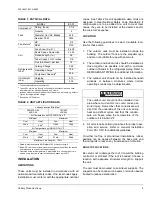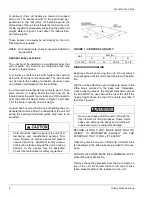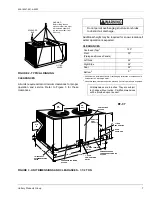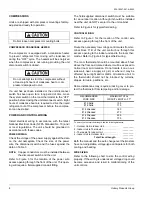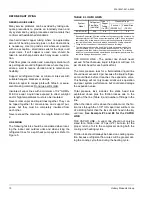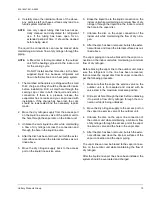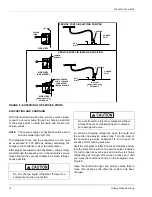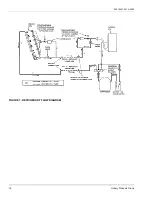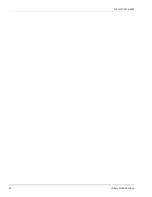
035-18547-001-A-0902
Unitary Products Group
19
4.
Relay RY1 also prevents the 10KW portion of
accessory electric heat referenced as standby
electric heat from being utilized whenever the com-
pressor is in operation. This part of the circuit is
covered under HEATING OPERATION.
5.
The thermostat will cycle the unit to satisfy the
cooling requirements of the conditioned space.
6.
After the unit has shutdown from a cooling cycle or
a power interruption, the anti-short cycle feature of
the defrost control board will not permit the unit to
restart for 5 minutes. This feature prevents the unit
from short cycling.
7.
If the discharge pressure reaches 430 psig, the HP
control will open and the defrost control board will
lock out the compressor. If the discharge tempera-
ture reaches 255°F, 2TH thermostat will open and
the defrost control board will lock out the compres-
sor. If the suction pressure falls to 7 psig, the low
pressure switch will open and the defrost control
will lock out the compressor.
8.
If the control that caused the lockout has automati-
cally reset, the unit can be restarted by one of the
following:
a.
Turning the system switch on the thermostat to the
“OFF” position and back to the “COOLING” position.
b.
Increasing the set point on the thermostat above the
temperature in the conditioned space and then
returning it to its original setting.
Opening and closing the power supply main disconnect
switch.
IN ALL THREE RESET METHODS DESCRIBED
ABOVE, A FIVE MINUTE TIME DELAY WILL TAKE
PLACE AFTER THE RESET BEFORE THE UNIT
WILL RESTART.
HEATING OPERATION
1.
Reversing valve is de-energized and the system
will be in the heating mode.
2.
If the fan switch on the thermostat is in the “ON”
position, indoor section blower motor contactor
10M will be energized through terminal G to pro-
vide continuous blower operation. If the switch is in
“AUTO” position, the blower will operate only when
thermostat calls for heating operation.
3.
When TH1 of the thermostat closes for first-stage
heat, a circuit is made from terminal Y through the
defrost control board and safety switches to ener-
gize contactor 1M and start the compressor. Con-
tactor 2M is energized through the NO contacts
RY1-1 which will start the outdoor fan motor(s).
NOTE:
If PS opens due to discharge pressure falling
below 180 PSI, the No. 2 fan motor will con-
tinue to operate through the NC contacts of
relay RW.
4.
The thermostat will cycle the unit to satisfy the
heating requirements of the conditioned space.
5.
After the unit has shutdown from a heating cycle or
a power interruption, the anti-short cycle feature of
the defrost control board will not permit the unit to
restart for 5 minutes. This feature prevents the unit
from short cycling.
6.
If the discharge pressure reaches 430 psig, the HP
control will open and the defrost control board will
lock out the compressor. If the discharge tempera-
ture reaches 255°F, 2TH thermostat will open and
the defrost control board will lock out the compres-
sor. If the suction pressure falls to 7 psig, the low
pressure switch will open and the defrost control
will lock out the compressor.
7.
If the control that caused the lockout has automati-
cally reset, the unit can be restarted by one of the
following:
a. Turning the system switch on the thermostat to
the “OFF” position and back to the “HEATING”
position.
b. Decreasing the set point on the thermostat
below the temperature in the conditioned space
and then returning it to its original setting.
c. Opening and closing the power supply main dis-
connect switch.
IN ALL THREE RESET METHODS DESCRIBED
ABOVE, A FIVE MINUTE TIME DELAY WILL TAKE
PLACE AFTER THE RESET BEFORE THE UNIT
WILL RESTART.
8.
Supplemental electric heat (if installed) will be con-
trolled by second stage TH2 of the thermostat. The
supplemental electric heat circuit is controlled
through low voltage terminals W, 60 and 66. The
standby portion of electric heat (controlled through

